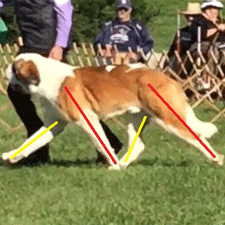
A vivid example of pacing can be found in an ad that Subaru put out a few years ago. One wonders how the execs who approved the commercial would have reacted had they heard dog fanciers across America mutter (and not in a good way): “Pacing.”
If, after watching the video, you still don’t catch the Poodle pacing, try this: Pacing occurs when a dog lifts two feet at the same time on the same side of their body. The two feet also hit the ground at the same time. Unless you have an Old English Sheepdog or Neapolitan Mastiff, and your conformation judge has asked you to walk your dog at a slower speed, pacing is typically unwelcomed in a show ring. That said, pacing doesn’t always indicate a fault. Some dogs pace when they’re anxious or stressed. Some dogs pace when they’re “hanging out,” waiting for someone or something. Some dogs pace when they’ve detected something you don’t want in your walls, like a rodent, and they may be simply alerting you. Even showdogs can pace at home because they’ve been on a treadmill or road-worked, they’re on their last stretch heading home or know they’re close to being done, and it’s less tiring than a trot. At home.
One source writes that liver disease may be a cause of pacing, suggesting that damage to the liver can cause abnormal neurological behaviors that include pacing, but this is usually paired with sudden changes in behavior. Cushing’s disease – the overproduction of the hormone cortisol – is also cited as a reason that a dog might start pacing, but this, too, is accompanied with wandering and restlessness.
In a show ring, however, pacing is considered a fault. This two-beat lateral gait sometimes called “side-wheeling” or “ambling” can be the result of poor structure and proportion – and evidence of fatigue, weakness, or lack of condition. Sometimes, interference can make a dog pace. A dog that is over-angulated may find it easier to switch the diagonals of their trot with constant clipping for the greater freedom of of a lateral gait instead of walking like a crab.
Pacing is understandable in a dog that has worked in the field or pasture all day, but for a mature show dog in a conformation ring for perhaps two minutes, is doesn’t usually end in the dog earning a ribbon.
ShowDogPrepSchool, a fine sponsor for National Purebred Dog Day’s Photo Contest on May 1st, offers a course that takes a look at what causes pacing in show dogs, and how to correct the movement issue. It is from them that we share our thumbnail image.

I know pacing (the gait), but are you also using word play to talk about pacing (the repetitive, stereotypical behavior)?
It is late and I am confused ><
No word play intended, Kate. The kind of pacing we’re discussing isn’t the stereotypical behavior seen in stressed/bored zoo animals, it’s a a gait recognized by using both legs on one side to move forward, and then both legs on the other side. The pace is a gait often used at the end of a long walk when a dog is tired. We came across this video that might help: https://www.youtube.com/watch?v=EbwDr3jzGXk